
* The Sikorsky company had been a pioneer in the development of heavy-lift helicopters for the US military, developing the "S-56 / CH-37 Mojave" during the 1950s. The S-56 left something to be desired, its twin piston engines not providing an adequate power-to-weight ratio. The development of turboshaft engines for helicopters promised a much better solution, which Sikorsky leveraged into a turboshaft-powered "flying crane" helicopter, the "S-64 Skycrane / CH-54 Tarhe". The S-64 proved successful and led to an even more successful derivative, the "S-65 / CH-53 Sea Stallion".
* In May 1958, Sikorsky began work on an experimental "flying crane" helicopter, the "S-60", derived from the S-56 / CH-37 Mojave heavy-lift helicopter. The S-60 inherited the S-56's rotor system and twin "power modules", each with a Pratt & Whitney (P&W) R-2800 Double Wasp radial piston engine, but had a stripped-down fuselage with long tailwheel landing gear that allowed it to straddle cargoes. The crew operated from a glassed-in nose module; the copilot could swing his seat around to face the back to keep an eye on sling loads, controlling the helicopter in this position with a secondary set of controls. The S-60 had an automatic stabilization system to allow it to hover precisely, using inputs from a sidestick controller.
The S-60 performed its first flight on 25 March 1959. It was intended only as a proof-of-concept demonstrator, since the company believed that a production machine would need to be powered by turboshaft engines for greater lift capability. Igor Sikorsky envisioned his flying crane carrying specialized modules or "pods", such as a field hospital or a radar station, as well as general heavy cargoes.
To investigate the S-60's ability to carry slung loads, Sikorsky had a test platform built, which he and two of his senior engineers took a ride on early in the flight test program. The two engineers found the ride somewhat nerve-wracking, but Sikorsky -- then about 70 years old -- simply strolled around the platform, checking the cable tension, as calmly as if he had been walking around on the ground. This was almost certainly not showing off; Sikorsky was a cultivated person with an Old-World sense of dignity. However, he had also been a pioneer of flight in the days when flying was dangerous in a big way, and no doubt it felt good to revisit some of the thrills of his youth.
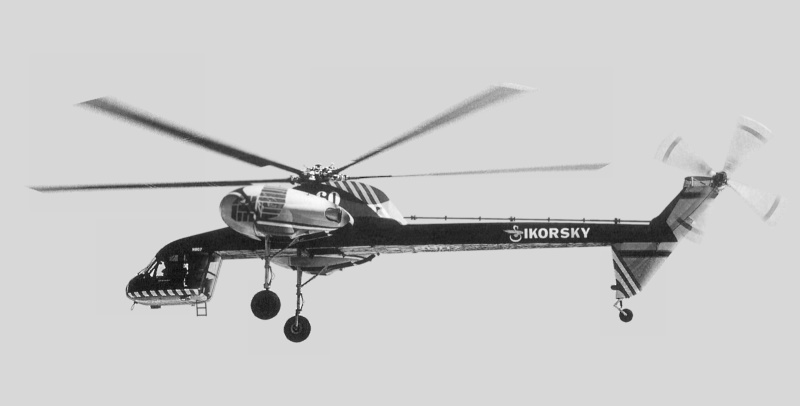
In any case, the company demonstrated the S-60 to the US Army and US Navy during 1960. The military had already worked on the development of flying crane helicopters in the early 1950s, though they were unable to bring a machine to production. The Navy was interested in demonstrations of the S-60 towing a minesweeping sled, and particularly interested in demonstrations in which it hauled cargoes between ship and shore. The S-60 crashed and was written off on 3 April 1961, the aircrew surviving with no serious injury. The wreck was stored, and is now being rebuilt for display by the Connecticut Air & Space Center in Stratford.
* With the Navy intrigued, Sikorsky began to move ahead on the production machine. The first obstacle was that a suitable turboshaft powerplant wasn't available. There were two engines under development that seemed like they could be adapted to the task, including the General Electric (GE) T64 turboshaft and the P&W JT12 turbojet. The problem with the GE T64 was that it had a front power shaft, and Sikorsky required a rear power shaft. GE didn't feel there was enough of a market to justify developing another major variant of the T64; while the problem with the JT12 was that it would require substantial work to turn it into a turboshaft. However, both Sikorsky and P&W were members of the United Aircraft (UA) industrial group, and senior UA managers immediately committed to building a turboshaft based on the JT12.
By the time of the loss of the S-60, the prototype for the turboshaft-powered "S-64 Skycrane" was already being built. The US military hadn't provided as much support as hoped for, but the West German government had decided to evaluate the S-64 and bought two of the first three evaluation machines built, the third being retained by Sikorsky for development testing.
The initial prototype had a general configuration along the lines of that of the S-60, but was a generally new machine. The cockpit had accommodations for pilot, copilot, and a rearward-facing crane operator / assistant pilot, plus folding seats for two passengers. It was powered by twin P&W "JFTD-12A" turboshafts -- as the JT12-derived turboshaft was designated -- with 3,020 kW (4,050 SHP) each, and had a six-bladed main rotor system, plus a four-bladed tail rotor. The tricycle landing gear had single wheels on each assembly. There was a retractable tail bumper.
The S-64 performed its initial flight on 9 May 1962. The Germans didn't place orders following their evaluation, but the US Army became interested enough in the machine to place an order for six "S-64A" helicopters for evaluation in June 1963, with the service designation "YCH-54A Tarhe", the name "Tarhe" being for an Indian chief of the Wyandot tribe in Ohio -- nicknamed, not incidentally, "Chief Crane" by the settlers. The S-64As were similar to the prototypes, but had production P&W T73-P-1 (notice the military designation) turboshafts with 3,360 kW (4,500 SHP) each.
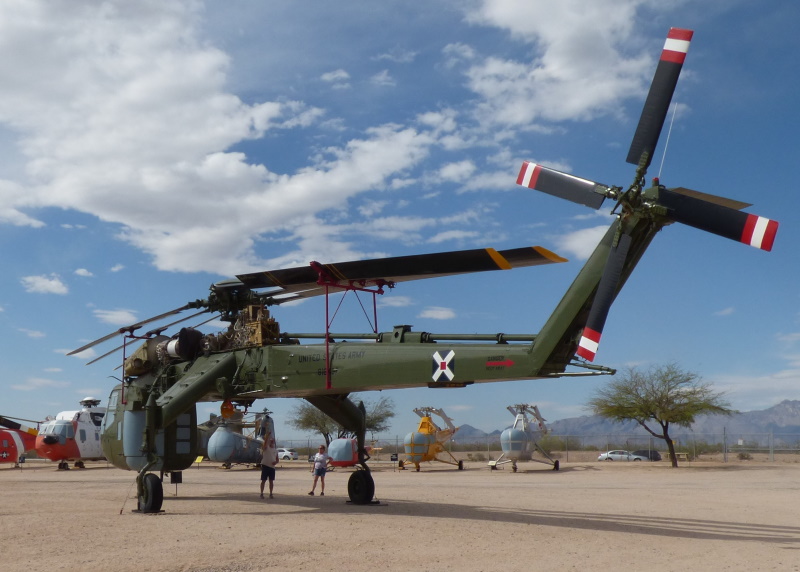
The evaluation went well, and was followed by orders for 54 full-production "CH-54As". This order was followed by another for 37 "CH-54Bs", featuring uprated P&W T73-P-700 engines with 3,580 kW (4,800 SHP) each; dual instead of single main gear wheels; and structural improvements to permit greater lift capacity. The CH-54B had actually been built under US Navy sponsorship as part of a dubious scheme to deliver Polaris strategic missiles to submarines at sea, but it fell well short of its load targets and the Navy never bought any S-64s. The last of the S-64s built for the US Army was delivered in 1972.
___________________________________________________________________
SIKORSKY S-64 / CH-54B TARHE:
___________________________________________________________________
main rotor diameter:
21.95 meters (72 feet)
fuselage length:
21.41 meters (70 feet 3 inches)
footprint length:
26.97 meters (88 feet 6 inches)
height (tail rotor):
7.75 meters (25 feet 5 inches)
empty weight:
8,725 kilograms (19,235 pounds)
max loaded weight:
19,050 kilograms (42,000 pounds)
maximum speed:
205 KPH (125 MPH / 110 KT)
range:
400 kilometers (250 MI / 220 NMI)
___________________________________________________________________
The Army deployed the type to Vietnam in 1965, initially sending four of the YCH-54A evaluation machines. The service found it very useful for delivering heavy equipment, and particularly for retrieving downed aircraft. Some sources claim it was also used to clear helicopter landing sites in jungles by dropping large bombs, though this mission, known as "Commando Vault", was more typically performed by C-130 Hercules transports.
However, the Tarhe was expensive, with a cost at least seven times greater than that of a Bell UH-1 Huey helicopter, and Sikorsky's concept of using modular pods turned out to be more of a logistical nuisance than a benefit in field military operations. Ironically, its modular design concept proved inflexible: the military wanted a helicopter that could be used as a skycrane and a transport, not one that had to be fitted with a special module for transport operations.
Operational losses were low, however, with one shot down and eight lost in mishaps in eight years of combat operations. There were problems with engine ingestion of fine dust and sand on hot and dry days, and so in 1967 Sikorsky developed a basket-like inlet cover, the "Engine Air Particle Separator (EAPS)", that sucked in air in a spiral flow to toss most of the dust and sand out of the inlet. EAPS was fitted to CH-54s in the field.
The Tarhe was retained in Army National Guard service until the early 1990s. It was not only used for military exercises, but also for fire-fighting, carrying a big water bucket on a sling. The Tarhe was finally replaced by the Boeing CH-47C Chinook, somewhat to the regret of the crews, who had found the Sikorsky machine to be capable and very reliable.

In the 1970s, Sikorsky did consider a next-generation version of the Skycrane, the "S-64B Super Skycrane", which featured three engines and a raised fuselage boom capable of carrying troops. It was an interesting idea, but Sikorsky went ahead with the S-80 instead, discussed in the next chapter.
* The Skycrane does soldier on in civilian service. In 1968, Sikorsky introduced a commercial variant, the "S-64E", equivalent to the CH-54A, and sold about ten of them for oil drilling, construction, logging, and forest fire fighting operations. The Skycrane is still working hard in fire-fighting and forestry operations, with the major operator being Erickson Sky-Crane in the US state of Oregon, which has 17 machines in service.
Erickson began using Skycranes for construction work in the early 1970s, and then increasingly focused on the helicopter itself. The company obtained manufacturing rights to the S-64 in 1992 and has been selling refurbished machines all over the world, with CH-54As becoming S-64Es and CH-54Bs becoming "S-64Fs", referred to by the company under the name "Air Crane". The company has supplied new-build spares and fire-fighting kit, and has developed a modernized AFCS. The new AFCS provided precision flight control that is very useful in flying-crane operations, particularly in emergency situations.
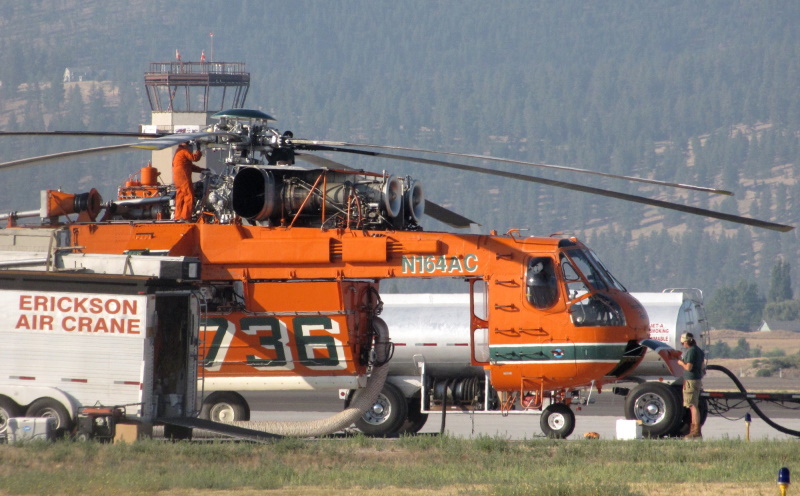
Erickson's literature has tended to downplay the fact that their helicopters are rebuilds, no doubt because they are sold in a "good as new" condition and there's no reason for customers to regard them as any less than that. However, in 2020 Erickson introduced the "S-64F+", with an updated engine, new composite main rotors, improved flight control and cockpit systems, an improved water cannon, and optional unpiloted operation. It is expected to lead to new production. The company has also considered development of a passenger module in response to feedback from firefighting and emergency response agencies.
BACK_TO_TOP* Although Sikorsky's high hopes for the S-64 didn't pan out, the company was able to use the basic technology to build a much more successful helicopter. In 1960, the US Marines began to seek a replacement for their old S-56 helicopters, originally working with the other three US armed services on the "Tri-Service VTOL transport", which would eventually emerge as the Vought-Hiller-Ryan XC-142A tiltwing. The word "eventually" is significant, because the design became more elaborate and the program stretched out. The Marines finally decided that they couldn't get a workable machine in a satisfactory timeframe, and dropped out. That was just as well, because the XC-142A, although a very innovative and capable machine, would never enter production.
In March 1962, the US Navy Bureau of Weapons, acting on behalf of the Marines, issued a request for a "Heavy Helicopter Experimental / HH(X)". The specifications dictated a load capability of 3,630 kilograms (8,000 pounds) with an operational radius of 185 kilometers (115 MI / 100 NMI) at a speed of 278 KPH (172 MPH / 150 KT). The HH(X) was to be used in the assault transport, aircraft recovery, personnel transport, and medical evacuation roles. In the assault transport role, it was to be mostly used to haul heavy equipment instead of troops.
In response, Boeing Vertol offered a modified version of the Chinook; Kaman offered a development of the British Fairey Rotodyne compound helicopter; and Sikorsky offered what amounted to a scaled-up version of the S-61, with twin GE T64 turboshafts and the dynamic system of the S-64, to be designated the "S-65". Kaman's proposal quickly died when the British government dropped its backing of the Rotodyne program. Competition between Boeing Vertol and Sikorsky was intense, with Boeing Vertol having something of an edge because the Chinook was being acquired by the US Army. Sikorsky threw everything into the contest, and was awarded the contract in July 1962.
The Marines originally wanted to buy four prototypes, but ran into funding problems. Sikorsky, determined to keep the deal, cut the estimate for development costs, and said that the program could be done with two prototypes. The military bought off on the proposal, and in September 1962 Sikorsky was awarded a contract for a little under $10 million USD for two "YCH-53A" prototypes, as well as a mockup and a ground-test airframe.
The development program did not go entirely smoothly, due to a shortage of engineering resources, plus various failings of subcontractors and the government, but the problems were gradually resolved. There was also the problem that US Defense Secretary Robert S. McNamara was pushing "commonality" between the armed services and pressuring the Marines to obtain the Chinook anyway, but the Marines managed to convince McNamara's people that the Chinook couldn't meet requirements without a lot of expensive changes.
All these obstacles overcome, the first YCH-53A performed its initial flight at the Sikorsky plant in Stratford, Connecticut, on 14 October 1964, about four months behind schedule. The Marines had already placed an initial production contract for 16 machines in September. Flight trials went more smoothly than expected, helping make up for the lost time in development, and the type entered USMC service in September 1965 as the "CH-53A Sea Stallion". The Marines were in such a hurry to get the CH-53A that they accepted it for service even before trials were completed. A total of 141 CH-53As was built, including the two prototypes.
The CH-53A was clearly inspired by the Sikorsky S-61R / Jolly Green Giant series, though it was a new design. The CH-53A had a passenger door on the left side of the fuselage behind the cockpit; a power-operated rear loading ramp; sponsons on each side of the rear fuselage; and tricycle landing retractable landing gear, with twin wheels on all gear assemblies and the main gear retracting into the sponsons. The fuselage was watertight, though the machine did not have a boat hull, was not really intended for amphibious use, and only landed on water in emergencies. Fuel was carried in tanks in the sponsons, with the bottom tank self-sealing to protect it from ground fire. Up to five 1,136-liter (300 US gallon) ferry tanks could be installed inside the fuselage.
The CH-53A featured a six-bladed main rotor and four-bladed tail rotor. To conserve space on board naval vessels, the tail boom and the rotors folded. Sources are confusing on the tail boom and rotor folding, making it unclear if this was a feature on all S-65 variants, and specifying automatic or manual folding mechanisms in an irregular pattern. It appears that folding was featured on all shipboard variants -- tail boom folding was generally or always manual, while rotor folding was generally automatic.
The rotor system was initially driven by twin GE T64-GE-6 turboshafts providing 2,125 kW (2,850 SHP) each, with one engine on each side of the forward fuselage. It was later produced with the T64-GE-1 with 2,300 kW (3,080 SHP) and then the T64-GE-16 with 2,600 kW (3,485 SHP). Controls were mechanical, backed up by two independent hydraulic servo systems and an automatic flight control system (AFCS). The EAPS inlet scheme was fitted to production machines, which were also fitted with a pintle mount in a hatch on each side of the fuselage for an M60 7.62-millimeter (0.30 caliber) machine gun, and carried 205 kilograms (440 pounds) of armor to protect the crew and vital mechanical systems.
The CH-53A could carry a crew of four -- pilot, copilot, crew chief, and "aerial observer" -- and a load of 38 troops; or 24 litters with medical attendants; or an internal cargo load of 3,630 kilograms (8,000 pounds); or an external load of 5,900 kilograms (13,000 pounds) on the single-point sling hook. The internal cargo bay was 9.14 meters long by 2.29 meters high by 1.98 meters wide (30 by 7.5 by 6.5 feet), and featured a roller system and tie-downs built into the floor. The CH-53A was a very capable machine, and it set several performance records; it could even perform loops and rolls.
* The CH-53A arrived in Vietnam in January 1967 and proved useful, eventually recovering even more downed aircraft than the CH-54, and in fact there are claims that the number of aircraft recovered paid back more to the USMC than the price of all S-65s obtained by the Marines. The S-65 was clearly much more along the lines of what the military really wanted than the S-64, and soon eclipsed it.
However, heavy lifting in tropical climates demanded more power, and so the Marines decided to acquire an improved variant, the "CH-53D", with uprated engines, originally the T64-GE-412 with 2,755 kW (3,695 SHP) and later the T64-GE-413 with 2,930 kW (3,925 SHP); an uprated transmission to take advantage of the more powerful engines, capable of handling 5,640 kW (7,560 SHP) on two engines and 2,820 kW (3,780 SHP) on one engine; and a revised interior to permit a load of 55 troops.
Initial flight of the CH-53D was on 27 January 1969, with initial service deliveries later in that year. A total of 124 CH-53Ds was built, plus another two "VH-53D" VIP transports, with were fitted with plush accommodations and used by the Marines for the US presidential flight. The VH-53Ds were eventually replaced by Sikorsky S-70 "Presidential Hawks".
___________________________________________________________________
SIKORSKY S-65 / CH-53D SEA STALLION:
___________________________________________________________________
main rotor diameter:
22.02 meters (72 feet 3 inches)
tail rotor diameter:
4.88 meters (16 feet)
fuselage length:
20.47 meters (67 feet 2 inches)
footprint length:
26.9 meters (88 feet 3 inches)
height (tail rotor):
7.59 meters (24 feet 11 inches)
height (rotor head):
5.22 meters (17 feet 2 inches)
empty weight:
19,050 kilograms (42,000 pounds)
max loaded weight:
23,485 kilograms (10,655 pounds)
maximum speed:
315 KPH (195 MPH / 170 KT)
service ceiling:
6,400 meters (21,000 feet)
range:
415 kilometers (260 MI / 225 NMI)
___________________________________________________________________
Although aircraft nicknames are always a tricky subject, nicknames associated with the H-53 series included "Hog", "Pig", "Piggy", "BigIron", and "Shitter" -- the last because its engines apparently tended to run dirty and smudge up the tailboom.
The CH-53D served alongside the CH-53A through the rest of the Vietnam War, with both types performing a final service at the end of the conflict in performing evacuations of personnel from Saigon and Phnom Pehn. The Marines lost 19 S-65s in Vietnam, including nine destroyed in combat and ten wrecked in accidents.
The older CH-53As were all phased out by the early 1990s, but the CH-53Ds continued in service. They were updated with defensive countermeasures, featuring an AN/ALE-39 chaff-flare dispenser containing 30 cartridges on each side of the tail boom, as well as an AN/ALQ-157(V)2 infrared countermeasures (IRCM) set. They were also armed with twin 12.7-millimeter guns, typically the M2 / XM218 Browning, instead of the lighter M60. Whether the more modern GECAL 50 3- or 6-barrel Gatling gun was ever fitted is unclear, though it seems plausible since it provides a much higher rate of fire than the famously plodding, if extremely well-proven and effective, Browning.
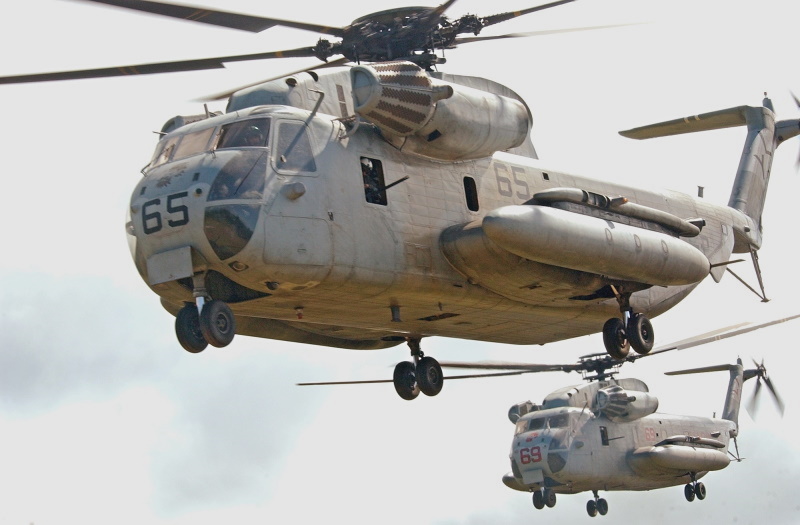
The CH-53Ds were retired in turn in 2012, being replaced by the CH-53E, discussed in the next chapter. Two CH-53Ds were apparently modified for the civil fire-fighting mission, but details are obscure.
BACK_TO_TOP* All but the first 32 of the CH-53As built had hardpoints for towing minesweeping gear. Following an evaluation, in 1971 the US Navy arranged for the transfer of 15 CH-53As with hardpoints from the USMC to the Navy for the "airborne mine countermeasures (AMCM)" role. Since towing a minesweeping sled requires a fair amount of power, these 15 Navy CH-53As were re-engined with T64-GE-413 turboshafts with 2,930 kW (3,925 SHP) each, and redesignated "RH-53A".
The RH-53As were also fitted with rear-view mirrors to allow the flight crew to keep an eye on the minesweeping gear; twin Browning 12.7-millimeter (0.50-caliber) machine guns to detonate mines whose anchor cables had been cut; and a frame that stuck out from the rear loading ramp to keep the tow cable from snapping up into the tailboom or tail rotor. The mirrors and the frame could be easily removed when the RH-53As were used in their secondary transport role. Minesweeping gear used by the RH-53A included:
These RH-53As, aided by some USMC CH-53As that had been temporarily modified as minesweepers, performed an extended series of sorties from February through July 1973 during Operation ENDSWEEP, involving the removal of mines planted in North Vietnamese waters as required by the dubious "peace treaty" signed between the US and North Vietnam in early 1973.
* The RH-53A was only intended as an interim solution until the Navy obtained the more powerful CH-53D for the AMCM role. The first RH-54D performed its initial flight on 27 October 1972 and deliveries to the Navy began in the summer of 1973, with a total of 30 acquired in all. Once the RH-53Ds were in service, the RH-53As were handed back to the Marines and restored to CH-53A configuration.
The RH-53D had the Browning guns, rear-view mirrors, plus cargo-ramp frame used by the RH-53A, and towed the same AMCM gear. The main improvement was fit of more powerful engines, originally the T64-GE-413A with 2,930 kW (3,925 SHP) as used on late CH-53Ds, but then the T64-GE-415 with 3,265 kW (4,380 SHP), as well as the stronger transmission system of the CH-53D. The RH-53D also featured a number of other improvements over the RH-53A:
AN/ALE-39 chaff-flare dispensers were fitted to the RH-53D. The RH-53D could be operated in the transport and SAR roles as secondary missions.
The RH-53D did not see service in Vietnam, but it was used for clearing Israeli-laid mines from the Suez Canal and Egyptian coastal waters after the Yom Kippur / Ramadan conflict in 1973, in Operation NIMBUS STAR in April 1974 and Operation NIMBUS STREAM in July 1975. The RH-53D was also used to clear mines during the Persian Gulf convoy operations in the late 1980s, under Operation INTENSE LOOK and Operation EARNEST WILL.
In addition, the RH-53D played a major, if notorious, role in Operation EAGLE CLAW, the ill-fated attempt to rescue hostages from the American Embassy in Tehran, Iran, on 24:25 April 1980. EAGLE CLAW was badly planned and executed. Eight RH-53Ds were assigned to the mission, to be flown in without markings, but they were obtained from regular operational units whose commanders were not informed that the machines were needed for a top-priority operation. As a result, the unit commanders passed on the RH-53Ds that they could most easily spare, meaning their hangar queens and gremlin nests. Worse, the helicopters ran into a sandstorm during insertion, and three failed en route.
The mission was scrubbed, but then one of the others drifted into a C-130 in the dark at the DESERT ONE site in Iran, resulting in the deaths of eight Americans. The mission was called off and all the other RH-53Ds were then destroyed or abandoned. The fiasco would eventually lead to the establishment of the joint-force US Special Operations Command (SOCOM).
All USN RH-53Ds have apparently been retired from service, though the details of when this happened and their fate are unclear.
BACK_TO_TOP* The US Air Force liked the Sikorsky S-61R / HH-3E Jolly Green Giant long-range combat search and rescue (CSAR) helicopters very much, and so were very interested in the more capable S-65. In 1966, the USAF awarded a contract to Sikorsky for development of a minimum-change CSAR variant of the CH-53A. The "HH-53B", as it was designated, featured:
Early HH-53Bs featured T64-GE-3 turboshafts with 2,300 kW (3,080 SHP), but these engines were later upgraded to T64-GE-7 turboshafts with 2,930 kW (3,925 SHP). Five crew were standard, including a pilot, copilot, crew chief, and two pararescuemen.
While waiting for delivery of the HH-53Bs, the Air Force obtained two Marine CH-53As for evaluation and training. The first of eight HH-53Bs performed its initial flight on 15 March 1967, and the type was performing CSAR missions with the USAF Aerospace Rescue & Recovery Service in Southeast Asia by the end of the year. The Air Force called the HH-53B the "Super Jolly". It was used for CSAR, covert combat operations, and "snagging" re-entry film capsules from photo-reconnaissance satellites.
* The HH-53B was essentially an interim type, with production quickly moving on to the modestly-improved Air Force "HH-53C" CSAR variant. The most visible difference between the HH-53B and HH-53C was that the HH-53C dispensed with the fuel-tank bracing struts. Experience with the HH-53B showed that the original tank was too big, adversely affecting performance when fully fueled, and so a smaller 1,705-liter (450 US gallon) tank was adopted in its place. Other changes included more armor and a more comprehensive suite of radios to improve communications with C-130 tankers, attack aircraft supporting CSAR actions, and aircrews awaiting rescue on the ground. The HH-53C was otherwise much like the HH-53B, with the more powerful T64-GE-7 engines.
A total of 44 HH-53Cs was built, with introduction to service in August 1968. Late in the war, they were fitted with countermeasures pods to deal with heat-seeking missiles. As with the HH-53B, the HH-53C was also used for covert operations and snagging re-entry capsules, as well as snagging reconnaissance drones. A few were assigned to support the Apollo space program, standing by to recover an Apollo capsule in case of a launchpad abort, though such an accident never happened.
* In addition to the HH-53Cs, the Air Force obtained 20 "CH-53C" machines for more general transport work. The CH-53C was apparently very similar to the HH-53C, even retaining the rescue hoist, the most visible difference being that the CH-53C did not have an inflight refueling probe. Since CH-53Cs were used for covert operations, they were no doubt armed and armored, just like HH-53Cs.
The Super Jollies made headlines in November 1970 in the unsuccessful raid into North Vietnam to rescue prisoners-of-war from the Son Tay prison camp, as well as in the operation to rescue the crew of the freighter MAYAGUEZ from Cambodian Khmer Rouge fighters in May 1975. The Air Force lost 17 Super Jollies in the conflict, with 14 destroyed in combat -- including one that was shot down by a North Vietnamese MiG-21 on 28 January 1970, while on a CSAR mission over Laos -- and three lost in accidents.
The HH-53B, HH-53C, and CH-53C remained in Air Force service into the late 1980s. Super Jollies operating in front-line service were painted in various camouflage color schemes, while those in stateside rescue service were painted in a natty overall gray scheme with a yellow tailband. A good number of Super Jollies were converted into PAVE LOW special-operations machines, discussed later.
BACK_TO_TOP* The USAF's Super Jollies were excellent helicopters and were appreciated by the service, but they were more or less daylight / fair weather machines, and downed aircrew were often inconsiderate enough to get into trouble at night or in bad weather. A limited night / foul weather sensor system designated "PAVE LOW I" based on a low-light-level TV (LLLTV) imager was deployed to Southeast Asia in 1969 and combat-evaluated on a Super Jolly, but it left much to be desired in terms of reliability.
In 1975, an HH-53B was fitted with the much improved "PAVE LOW II" system and redesignated "YHH-53H". This exercise proved much more satisfactory, and so eight HH-53Cs were given a further improved systems fit and redesignated "HH-53H PAVE LOW III", with the YHH-53H also upgraded to this specification. All were delivered in 1979 and 1980. Two of the HH-53Hs were lost in training accidents in 1984, and so two CH-53Cs were brought up to HH-53H standard as replacements.
The HH-53H retained the inflight refueling probe, external fuel tanks, rescue hoist, and three-gun armament of the HH-53C; armament was typically a Minigun on each side, and a Browning 12.7-millimeter gun in the rear to provide more reach plus a light anti-armor capability. The improvements featured by the HH-53H included:
The FLIR and TFR were mounted on a distinctive "chin" mount. The HH-53H could be fitted with 27 seats for troops or 14 litters. The upgrades were performed by the Navy in Pensacola, reflecting the fact that the Navy handled high-level maintenance on Air Force S-65s.
In 1986, the nine HH-53Hs were given an upgrade under the CONSTANT GREEN program, featuring incremental improvements such as a cockpit with blue-green lighting compatible with night vision goggles (NVG). They were then reclassified as "special operations" machines and accordingly given a new designation of "MH-53H".
* The HH-53H proved to be a good thing and the Air Force wanted more of it, coming up with an "MH-53J PAVE LOW III Enhanced" configuration. The general configuration of the MH-53J was similar to that of the HH-53H, the major change being fit of twin T64-GE-415 turboshafts with 3,265 kW (4,380 SHP) each, as well as more armor, giving a total armor weight of 450 kilograms (1,000 pounds). There were some avionics upgrades as well, including fit of a modern Global Positioning System (GPS) satellite navigation receiver. A grab-bag of 32 HH-53Bs, HH-53Cs, and CH-53Cs was upgraded to the MH-53J configuration from 1986 through 1990, with all nine MH-53Hs upgraded as well, giving a total of 41 MH-53Js.
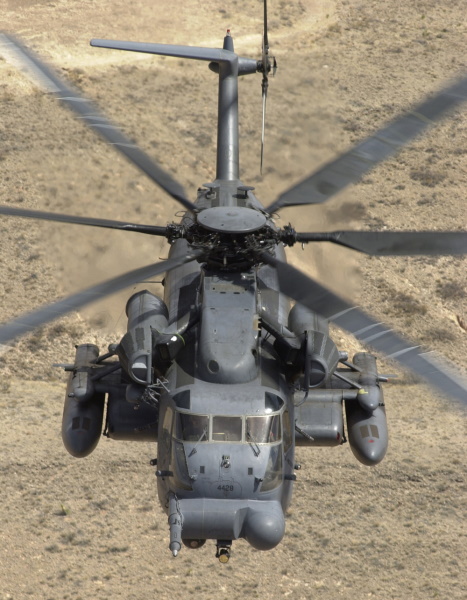
The MH-53J went into service with SOCOM in 1987, which became (as far as the USAF was concerned) the Air Force Special Operations Command (AFSOC) in 1990. The MH-53J served in the invasion of Panama and saw extensive service during the Gulf War, where it was used to insert Special Operations teams deep in the Iraqi desert to hunt for Iraqi "Scud" ballistic missiles. It was used in other conflicts in the era of "dirty little wars".
The Air Force ran the MH-53J fleet through a series of upgrades, including a "service life extension program (SLEP)" that both extended their service lives and increased their top load capacity by 45%. Another upgrade fitted to the MH-53Js was a folding tail boom and automatic main blade folding for shipboard storage and air transport. 25 MH-53Js were fitted with an improved defensive avionics suite and a datalink terminal, to be redesignated "MH-53M".
In the mid-1990s, six low-time CH-53As retired from the Marines were acquired by the Air Force as trainers, to be redesignated "TH-53A". The MH-53Js were heavily tasked, and the TH-53As provided additional airframes for training exercises. The TH-53As were gradually up-engined to T64-GE-415 engines and fitted with probes for inflight refueling training. They were not fitted with full operational equipment and were regarded as nice to fly, having a relatively low empty weight compared to the MH-53J. Some sources reference the upgraded TH-53As as "TH-53Bs", but this appears to be an error.
The PAVE LOW was finally retired in late 2008, after performing its final operational mission in Iraq. It was replaced by the CV-22B Osprey tiltrotor.
BACK_TO_TOP* The S-65 was sold to a number of countries. In the late 1960s, West Germany began a competition for a helicopter to replace Piasecki H-21 Flying Bananas and Sikorsky H-34s in West German Army service, and awarded a contract to Sikorsky for the "CH-53G", basically a CH-53D without refueling probe or external tanks, in June 1968. Sikorsky provided two machines directly, and then provided kits to a group led by VFW-Fokker for the construction of 20 more. Initial flight of a German-assembled CH-53G was on 11 October 1971, with the type going into West German Army service in 1973. 90 more CH-53Ds were built in West Germany with a decreasing level of Sikorsky content, for a total of 112 machines in West German service.
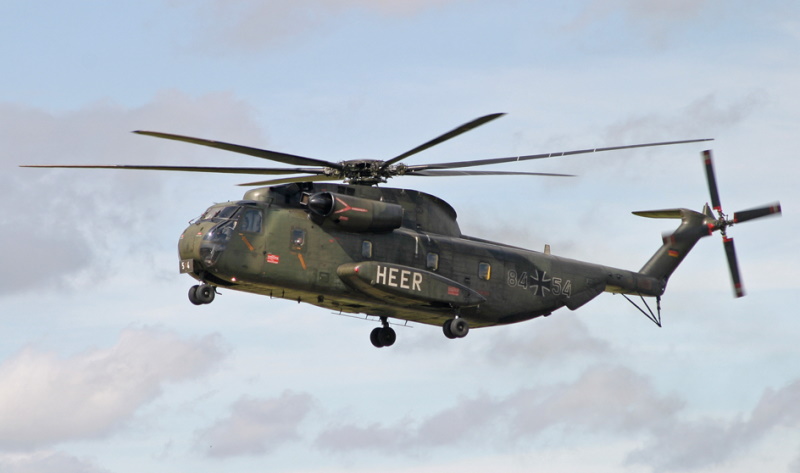
The German machines were upgraded in service:
The Germans are now phasing out their CH-53s, with the last to be retired in 2030. Other foreign S-65 operators have included:
Sikorsky gave some thought to selling the S-65 for commercial operations, even modifying a CH-53D to an airliner demonstrator configuration under a US National Aeronautics & Space Administration (NASA) contract. This "S-65C" machine, also known as the "Ride Comfort Research Aircraft (RCRA)", was used for tests for two decades, but it did not lead to a commercial variant or commercial sales. There was never much of a civil market for big new-build helicopters.
BACK_TO_TOP